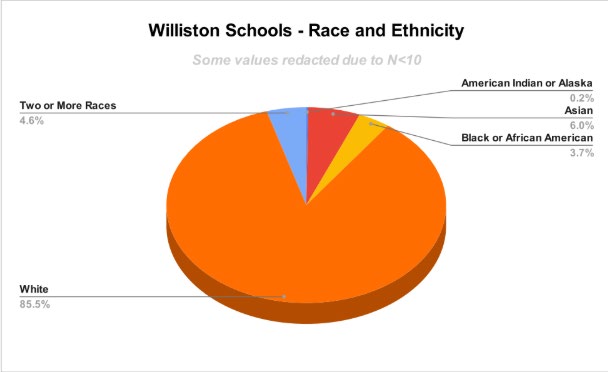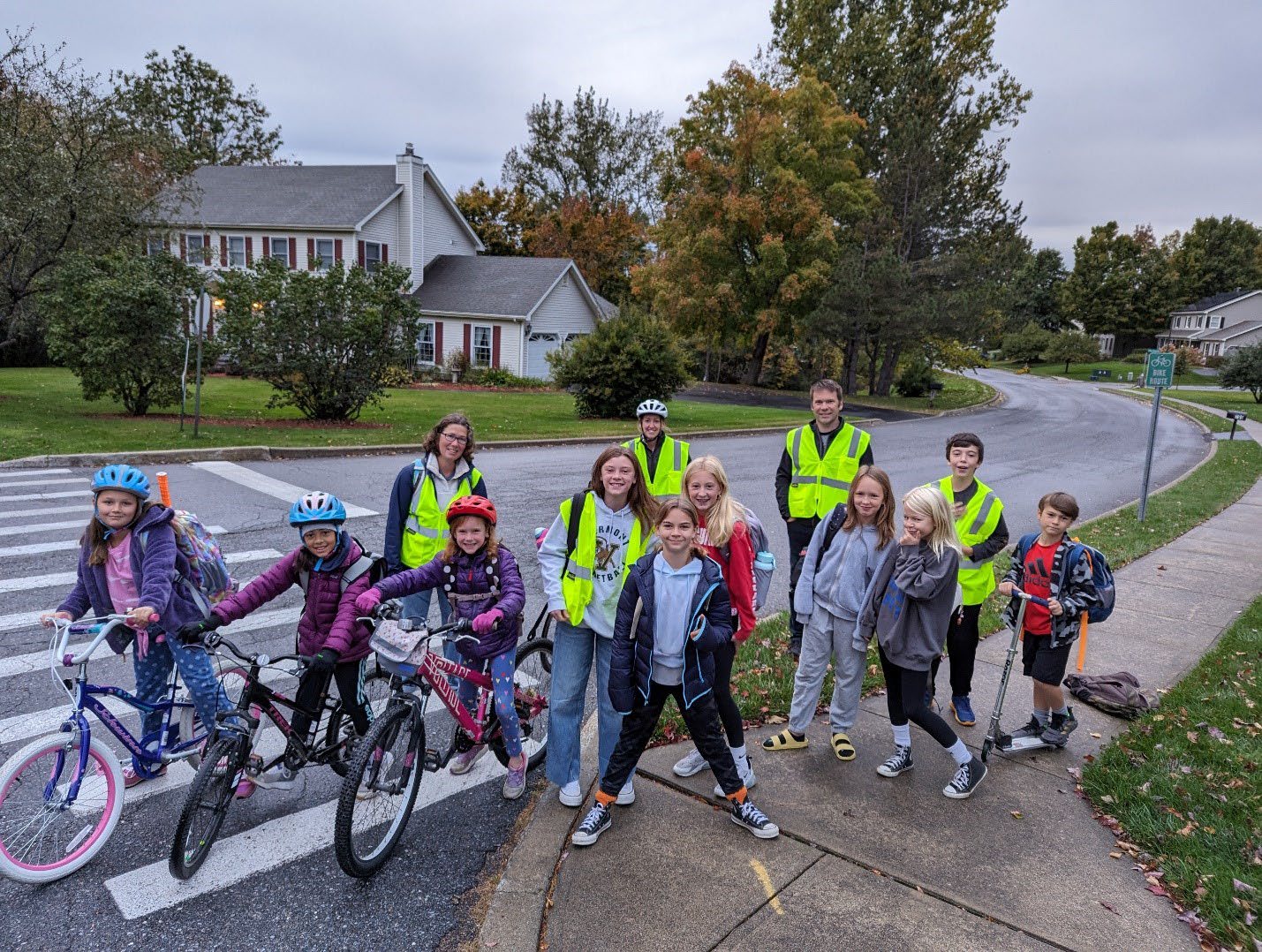Introduction
In Williston, education has several elements, all of them interrelated. Education is a holistic experience, and as such, many elements are required to create well-rounded kids who are fully functional in society while living their most authentic lives. Williston has two public schools, Allen Brook and Williston Central School, but they do not stand alone. Immediately adjacent to Williston Central School is the Dorothy Alling Memorial Library, a close partner of both schools, and Williston Community Park and playground, with its various ball fields, seasonal ice hockey rink, skate park, primitive trails, basketball and volleyball courts, and other amenities. Running immediately behind Allen Brook and Williston Central is the Williston Bike Path, used by students and teachers alike to travel to and from school and to engage kids in physical activities.
Schools are not managed by town government; they have their own elected officials--school boards-- responsible for operations and curricular programming. Williston schools are part of the Champlain Valley School District, which also includes the towns of Hinesburg, St. George, Shelburne and Charlotte. The Allen Brook School and Williston Central School provide grades K-8 education for Williston and St. George children. Champlain Valley Union High School in Hinesburg serves children in grades 9-12 from the five district towns.
At full capacity, Allen Brook and Williston Central School meet the needs of 1,250 students. 1Munson, Michael. School Impact Fee Analysis. Town of Williston, Vermont. June 1, 2012.
Vermont Education Dashboard: Enrollment. Vermont Agency of Education, Montpelier, Vermont. https://education.vermont.gov/data-and-reporting/vermont-education-dashboard/vermont-education-dashboard-enrollment. Accessed May 29, 2024.
Munson, Michael. School Impact Fee Analysis. Town of Williston, Vermont. June 1, 2012.
Vermont Education Dashboard: Enrollment. Vermont Agency of Education, Montpelier, Vermont. https://education.vermont.gov/data-and-reporting/vermont-education-dashboard/vermont-education-dashboard-enrollment. Accessed May 29, 2024.
Relationship between Housing Growth and School Enrollment

FIGURE 1: RELATIONSHIP BETWEEN HOUSING GROWTH AND SCHOOL ENROLLMENT
Despite steady population and housing growth, Williston and CVU school enrollment has been flat or declining over the past two decades. In 2022, Statistical Forecasting LLC completed a demographic study for the Champlain Valley School District, projecting grade-by-grade enrollments from 2022-23 through 2031-32, a ten-year period. This study sheds light on the complex and often misunderstood relationship between housing growth and school enrollment. The primary finding is that there are many other factors that influence school enrollment such as population age structure (the relative proportions of the population in each age group), birth rates, in-migration rates, length of home ownership and the type of housing being built – apartments yield an average of .105 of a student per unit as compared to .394 student per single family home.5Statistical Forecasting, LLC. Demographic Study for the Champlain Valley School District. March 2022.
New Homes and People: 5-Year Outlook – Predicted Residential and Commercial Growth FY26-30. Memorandum from Williston Planning Staff to Williston Selectboard. November 19, 2024. Accessed 2/28/2025 at Agenda Packet - November 19, 2024 - Selectboard Meetings 2024 - Town of Williston, Vermont
Past school enrollment and future projections derived from Vermont Agency of Education, as cited in previous Town Plans. Number of homes built was derived from Department of Planning and Zoning data (Certificates of Occupancy issued).
School Taxes are Increasingly Burdensome
Despite flat enrollment trends, school tax burdens have increased as a proportion of property tax value. Since the 1997 passage of Act 60, Williston has been challenged to maintain high quality education at a reasonable cost to the town. Williston is classified as a "sharing town," meaning that the amount of school tax revenues generated in Williston exceed the amount of revenues spent on education in Williston. The balance is distributed by the State to towns that have significantly lower tax base resources (the "receiving towns"). This affects affordability for Williston residents, as well as the town government's budget. If people feel overly burdened by the school property tax, they are less willing and able to bear the burden of increased municipal taxes. Pressure to keep municipal taxes level will strain the municipal budget, making it challenging for the Town to make progress on meeting its long-term goals.
Despite the increasing burden of school taxes-- which the Town cannot control-- the Town should continue to invest in good streets, green space, paths and trails, affordable housing and other amenities that make Williston a great place to live, work and recreate.
Williston's Schools are Diverse
Williston's schools are diverse, a quality that brings depth and richness to the educational experience. more than fifty children are multilingual learners; 14.5 percent are ethnically non-white; and 20 percent are economically disadvantaged.
CVSD is working on developing a better understanding of how to meet the needs of its diverse student body, including providing services to unhoused students and their families and to students with special needs. During the 2023-2024 school year, 24 students within the Champlain Valley School District were unhoused, up from 17 the year before. Five of them were enrolled in Williston schools. 3Munson, Michael. School Impact Fee Analysis. Town of Williston, Vermont. June 1, 2012.
Diversity of Educational Institutions and Programs
Of course, education comes in many forms, and Williston offers a broad cross-section of them. ABS and WCS incorporate unique outdoor and life skills education programs such as the Four Winds Program,10Williston Four Winds. https://sites.google.com/cvsdvt.org/willistonfourwinds/home Accessed 5/29/2024.
Williston Schools Points of Pride. Champlain Valley School District 2024-2025 Proposed Budget and Annual Report. Champlain Valley School District. Shelburne, Vermont. Accessed June 7, 2024 at https://docs.google.com/document/d/1ms8qVP1n8wcKLLuKfEE9HloOqf20KELbFGJHE9cB924/edit
Childcare Needs
For kids younger than five, Williston has fourteen licensed childcare providers and six registered homes serving a total in-care population of 1,134. Does this meet the needs of Williston's population? Based on reported vacancies, the needs for preschool and school-aged care appear to be adequately met for the current population, while there appears to be a need for expanded infant and toddler care, both of which are addressed in the current town plan.12Vermont Agency of Human Services, Department for Children and Families. Vermont Childcare Provider Data. Accessed 5/6/2025 at https://data.vermont.gov/Education/Vermont-Child-Care-Provider-Data/ctdw-tmfz/about_data?_gl=1*pcpk3k*_ga*MTE0NDM5NjQxOS4xNjU0MTc0MDAx*_ga_V9WQH77KLW*czE3NDY1NDQwNTkkbzE1MSRnMSR0MTc0NjU0NTc4MiRqMCRsMCRoMA.
A Vision of the Future of Education in Williston
> A child without education is like a bird without wings.
> —Tibetan Proverb
Early on a Monday morning, as teachers work bleary-eyed in their classrooms, coffee in hand, preparing for the day ahead, Students converge on their schools. Some are dropped off by parents, and some still arrive aboard the now limited number of electric school buses that serve the more distant parts of Williston. But something is different: the bike path that winds its way throughout the town is buzzing with noisy activity. Large numbers of kids ride their bikes to school, and an equally large number walk in great long trains from neighborhoods in the village, South Ridge and North Ridge, Brennan Woods, the Finney Crossing area at Taft Corners, and all the other nearby neighborhoods, now seamlessly connected by the town's network of bike paths. Adult volunteers amble along the bike trail at intervals, ever watchful, ready to fix a chain that has jumped its sprocket, apply a band-aid to a scraped knee, adjust a bike helmet, or offer a suggestion about a book to read from one of the many tiny libraries that are installed along the route.
This is as much a part of childhood education in Williston as classroom time. Walking or riding to school provides physical exercise, socialization, unstructured fun, and an opportunity to engage with the natural world along the way, something the Williston Bike Path network offers in bucketloads.
The school day is as dynamic and multifaceted as teachers and administrators can make it. Not only do kids spend time in traditional classroom settings as required to achieve their learning objectives, they also take part in regularly scheduled enrichment programs that are the result of a dedicated coordination effort between schoolteachers and administrators, parents, community volunteers, the town, and of course, the students themselves. Fundamental to this rich educational fabric is well-established, regular communications among the various players to ensure that seamless program integration and enrichment takes place.
Education is not limited to young students: equally involved are parents and other adults in the community who take part in educational programs both as participatory learners and presenters.
At any point during the educational day (which for many, may include evenings), children might be in the classroom with a teacher, learning core subject matter, or on a nature walk with a volunteer, learning about the sights and sounds and smells and textures of the natural world and why they are important; or learning outdoor skills like knot-tying, fire building, trail maintenance, navigating with a compass, safe boating, wildlife identification, photography, or a hundred other skills, all offered by a combination of teachers and skilled, experienced volunteers. They might spend a day with people who teach or work in skilled trades, learning about a wide variety of job types. Some might engage in ride-along programs with skilled professionals, sit in on college classes for a day at the local college campus at Taft Corners, engage in conversations with local political leaders, or shadow town officials to learn about the interplay among various town officials and functions.
Meanwhile, Williston's adult community attends programs offered at schools, libraries, and other facilities throughout the week, all part of the strategy to keep as many people as possible engaged in town goings-on to drive community involvement, inclusion, understanding, awareness, and lifelong education. Coordinated by town and library staff members, and based on community input and feedback, participants routinely attend programs about healthcare, planning for retirement, town goings-on, first aid training, and presentations about travel, food, the natural world, and other topics as requested.
At any given time, there are more than 50 unique programs underway in the town, all designed to support Williston's commitment to being an equitable, affordable, and resilient community, a place that celebrates the remarkable "diversity of the diversity" of the Williston community. Education in Williston is seen as much more than traditional classroom time, and it transcends age. The community does not see education as a one-and-done process, but rather as a lifelong pursuit that betters individuals and the town itself. Williston is a model for surrounding communities, because of the way it has woven a tight educational fabric from many disparate threads: physical schools, online learning environments, teachers, administrators, town officials, library programs and staff, parents, skilled community members, and of course, our students.





